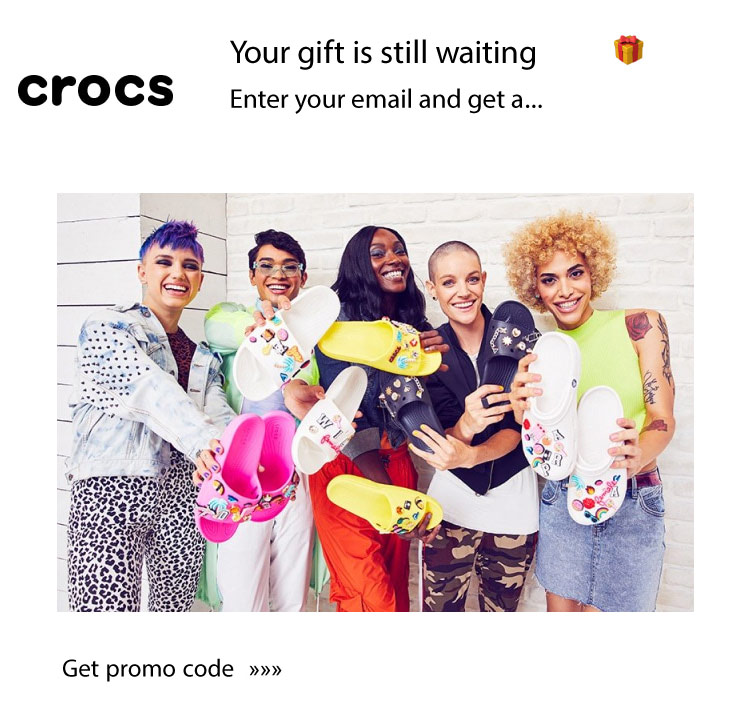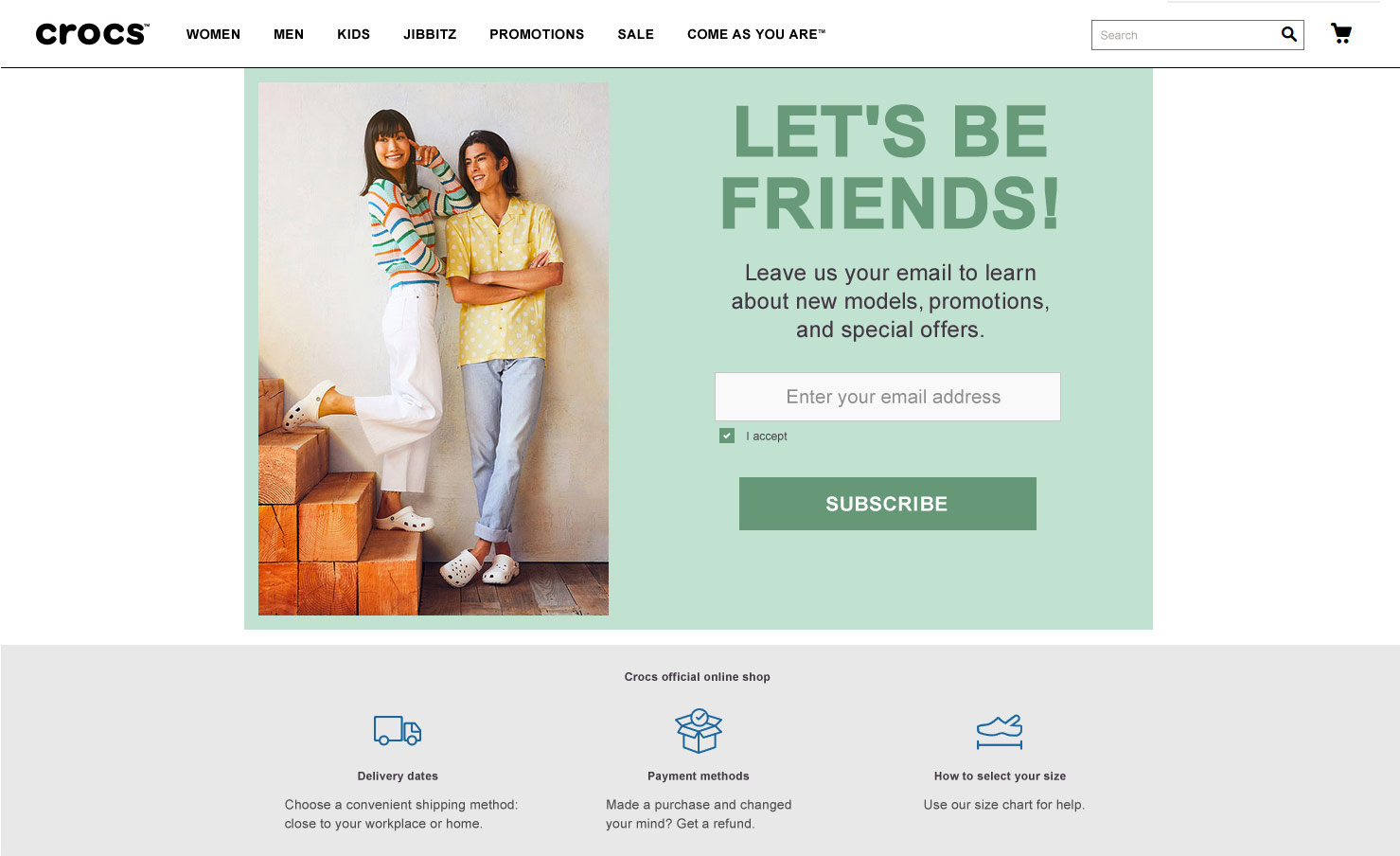How Crocs is Transforming its Marketing: Customer Insights, Valuable Content, Positive Emotions
How Crocs is Transforming its Marketing: Customer Insights, Valuable Content, Positive Emotions
Goals
Automate marketing to boost purchases in the email and web push channels
Results
31 triggers launched for the email and web push channels
IT stack.
Website, ERP software
The following case study is from Mindbox, the original brand behind Maestra’s technology
Marketing automation platform: implementation history
After the top managers of Crocs visited the CIS division in 2017, the team began to focus on growing their sales from digital channels. The primary focus was on the online store and marketplace giants like Lamoda, Ozon, Wildberries, and Tmall. In the CIS, the online store is an independent unit controlled by the CEO of the division.
Initially, the online store’s audience was not segmented. Customers used to receive lots of general emails like “Sale! Shop now!”. To make communication with customers more personalized and meaningful, Crocs needed a platform that would support a unified database to store its entire history of customer interactions. Crocs was looking for a way to fine-tune segments and triggered messages related to these segment.
In 2018, the platform choice was based on a questionnaire consisting of 40 criteria. Mindbox was not Crocs' first choice as the team was not impressed with the pre-implementation consultation.
In 2019, however, Crocs stopped using the first platform as it had certain internal limitations. Around this time, Crocs reps met Ivan Borovikov — the founder of Mindbox. The platform’s functionality seemed to be a good fit for the challenges they had, so the parties agreed to start the implementation. Since then, Crocs has been using Mindbox to store all the unified customer profiles and launch manual and automated emails and web pushes.
There is a single marketer to handle everything from creating a content plan to launching campaigns and analyzing results.
Initial goals and challenges. First of all, we wanted to figure out who our customers were and what they were buying. We needed to identify our customers’ behavior in brick-and-mortar and online stores to make our emails more targeted.
Our approach to communications tended to look like this: once a sale started we sent text messages and emails to our entire contact base. After that, nothing else happened.
Furthermore, we couldn’t tell which purchases came from email campaigns and which came from offline channels, such as banners in store windows. We also wanted to know what had led to a purchase: a promo text, a banner on our website, or a bold store banner stating “50% off sale, don’t miss out!”
So, due to lack of data, our customer base was not segmented, we couldn’t tell how often customers bought our footwear, and communications with each member of our audience were exactly the same.
Our results after Mindbox. With all data finally aggregated and accessible, we now better understand our customers and have way more insights into their preferences and shopping habits. For example, unlike other footwear retailers, we discovered that our birthday discounts — unexpectedly — didn’t increase sales.
So instead, we are now sending out more content-rich emails without an aggressive call-to-action tone. On the whole, the result of this approach is only slightly inferior to our regular promo emails, with revenue differing by just 10–12%. Even so, the open rate of emails has increased, indicating that customers are reading our messages with higher interest.
Our primary mission was to use Mindbox to engage customers. But first we had to figure out what our goals really were. We didn’t intend on making a huge profit from our email channel. Rather, the main idea was to initiate a reliable tool to engage customers, trigger leads, and support communication. To achieve these goals, we now have both our manual and automatic campaigns powered by Mindbox.
Amazingly, our customer base grew and is still growing! In 2019, we doubled our customer base, and this year we forecast an increase of about 150%. This resulted from our improved campaigns — for example, introducing a welcome bonus — a lead generation plan, and working with an agency that brings us new customers.
Our marketing approach: We plan to continue transforming our manner of communication by offering valuable content. We have to look appealing to customers, appearing more casual and festive. Crocs is a brand with a vibrant summer vibe — charismatic, warm, buzzing, comfy, cheerful — and we want to emphasize that aspect.
We want to avoid coming across as a discount store where all communication is conveyed exclusively through aggressive promo emails.
Instead, we want to make our communication more personalized. That means using trigger messages like: “Buy and read something interesting about Crocs, ” for example, rather than: “Make a purchase and get a gift.”
Automatic Campaigns Launched
The first thing we did was transfer the campaigns from the previous platform to Mindbox. This included email confirmations, abandoned carts, abandoned browses, and in-cart discounts. This transfer all happened within one week.
Next, Mindbox launched some new campaigns to include more customer behavioral scenarios. The team started with the email channel as this has the highest level of engagement among customers and because it gave us more opportunities to create valuable and visibly appealing content. Next, we launched web push notifications.

Marketing campaign list made for Crocs
Automatic Campaigns: Examples
Email: Discount Digest
Those who have not shopped with us for some time receive monthly emails about popular Crocs products on sale. The content of the email changes to fit the interests of the customer. For example, they may receive a discount for children’s footwear if they had viewed items for kids, or for men’s footwear if they had viewed items for men.

The discount digest is based on the interests of the customer and their previous orders.
We moved away from aggressive sales emails, towards celebrity collaborations and content marketing emails.
For example, we collaborated with Post Malone. Then, thanks to our new strategy, we sold 200 pairs of shoes in 40 minutes at full market price without any discounts.
We simply designed a subscription form, added all subscribers to a specific Mindbox segment, and sent them occasional product launch reminders. What’s more, it was in the middle of Black Friday, when shoppers normally won’t buy anything without a discount.

Product launch email promoting the Post Malone x Crocs collab
Web Push: Collecting Email Addresses
The web push channel is a double-edged sword. A customer can easily subscribe to push notifications and abandon their cart without providing contact information. If a customer had subscribed to push notifications but did not leave an email address, they then receive an automatic notification asking them to enter their email address in exchange for a gift. On average, 2% of push recipients convert to email subscribers.
Once the customer clicks on the push notification, they’re taken to a special landing page where they enter their email address. After that, they receive a verification email. Once the customer confirms their address, another message is sent with a gift in the form of a promo code.

Among those who get a push email, 2% convert to email subscribers

Enter your email, confirm it, and receive your promo code!
Email: Calculating NPS on Fulfilled Orders
After completing an order, the customer receives an automatic email with a request to rate the quality of service on a 1 to 5 point scale.


Crocs Service Quality: Points Statistics
Once a customer evaluates the service, they are redirected to another page where they can provide more detailed feedback. Before using this tool, Crocs received only about 15 evaluations over 3 years. Once the new service feedback format had been implemented, 135 new evaluations were submitted within 4 months.
Mindbox helped us to build a more effective means of communication with our customers. Now we are able to regularly keep in touch with clients without spending a lot of time doing so.
One successful solution was to set up a trigger email with a request to leave a review. As a result, we’ve received a lot of positive feedback, which subsequently has increased both new and potential customer buying confidence.
I also want to note the platform’s intuitive interface and the system’s ability to generate detailed reports. Special thanks to Mindbox’s project manager for their prompt assistance and high level of involvement while working with us.
Marketing Development Plans
Our next step is to transfer product recommendations for customers to the website from a separate host service. In this case, customer recommendations will be more personalized, based specifically on a shopper’s order history.
Looking towards the future, we will continue to launch new and useful automated campaigns.
As of now, we are in the process of making plans for 2023 — 2025. We can already predict our future revenue and have been able to determine a marketing budget. We know exactly what we will be doing to keep growing.
The most exciting thing — the pinnacle of our Mindbox experience — will begin next year. First, we will finish some basic trigger features. Next, we will bring a lot of our ideas to fruition — from segmentation to expanding our scope of Mindbox features. Our current marketing activities have already resulted in our revenue growing exponentially. We expect to double or even triple our revenue throughout the year and will continue to do so going forward.
In addition, we plan to introduce attention-grabbing triggers and recommendations. For example, clogs buyers will get the Jibbitz catalog and instructions on how to attach Jibbitz charms.
We love to experiment and will continue to do so. For example, we had an absolutely amazing campaign where we took an audience of swimwear buyers and combined it with an audience that visited travel agency websites. We then displayed Crocs banners with a welcome promo code on the websites they visited. The campaign’s results were awesome.
I also have a new idea to launch an extended welcome email series with 10 emails to be sent over the course of 6 months. We will know exactly when we initiated communication with a client, what they buy, and which products they browse.
For a monobrand like ours, email marketing will never be an “instant” source of revenue. This is where contextual advertising, and Instagram and Facebook banners shine — leading our audience towards making impulsive purchases. The email channel, on the other hand, implies long-term communication. Moreover, each email campaign needs careful planning to attract and retain our audience.
Our aim with emails is to create fun content that results in positive emotions and presents new, amazing collaborations that sell out in 10 to 15 minutes. That is where the Mindbox platform truly helps us excel.



